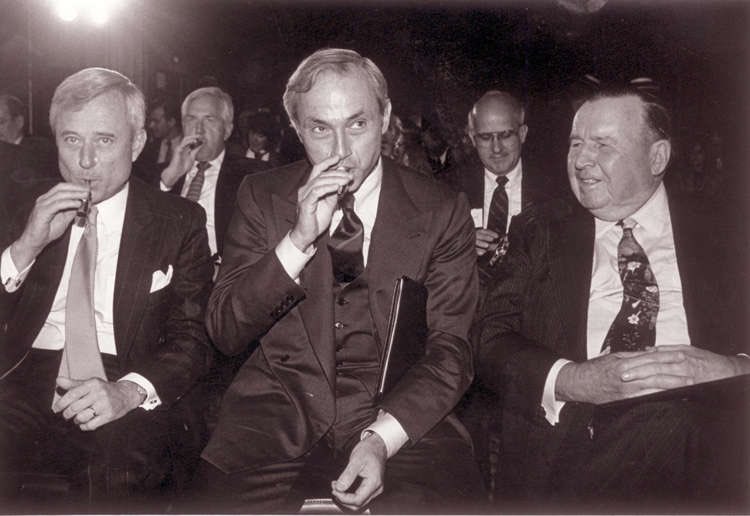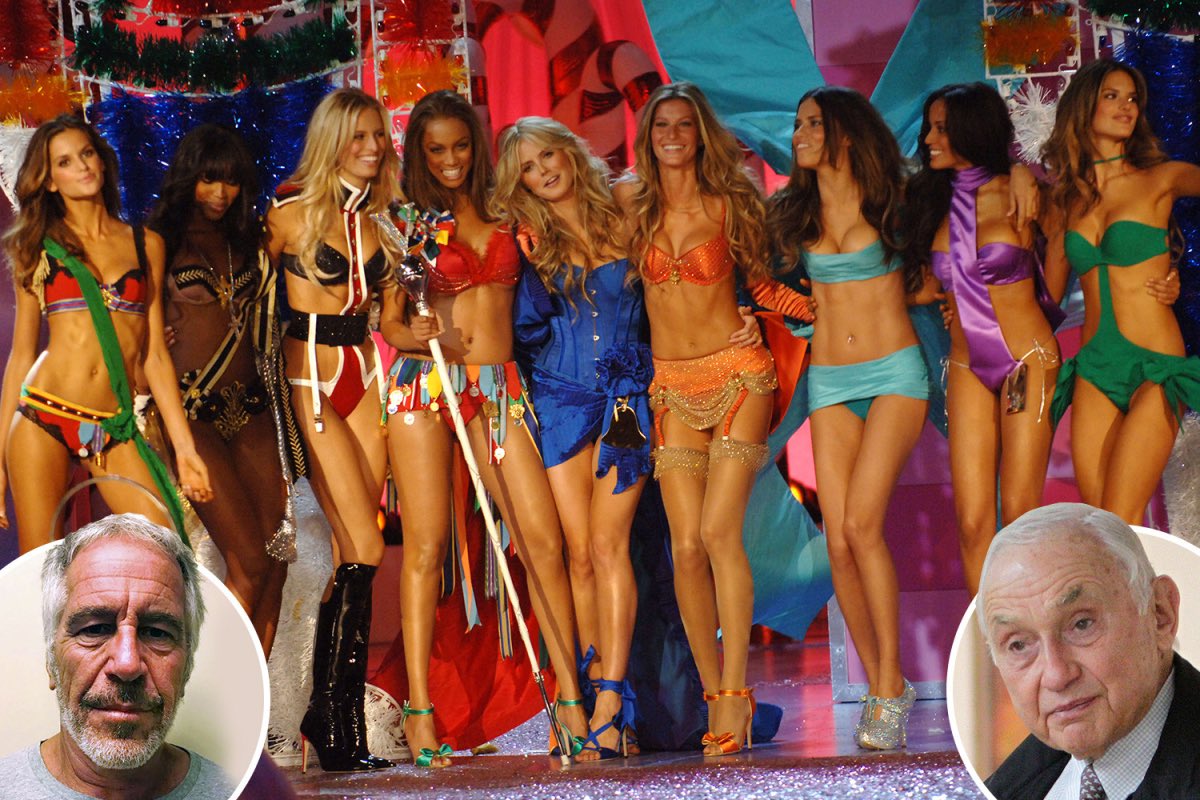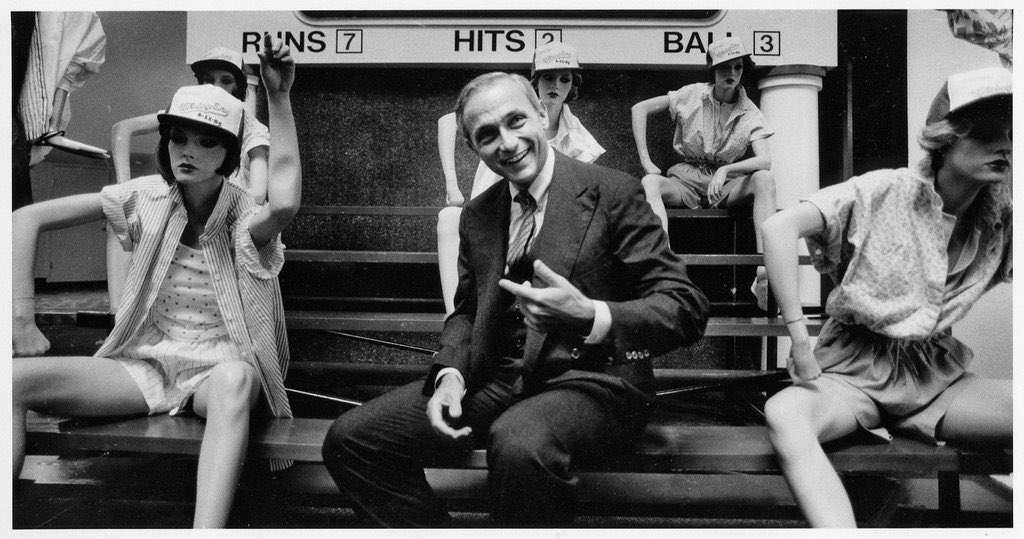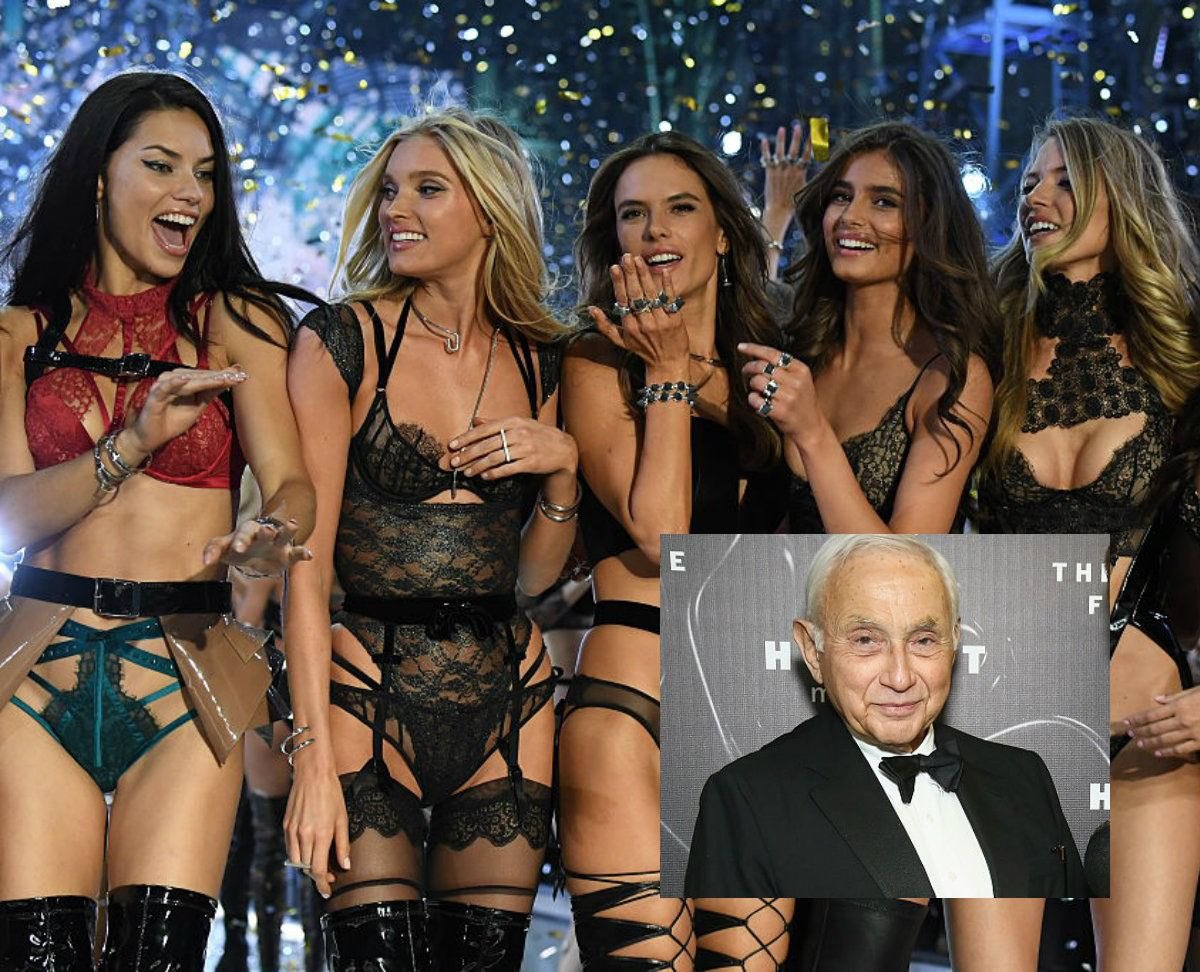
Banque de Crédit International Genève (also known as "BCI") was a Swiss bank, founded in 1959 by Tibor Rosenbaum and Bernard Cornfield in Geneva, Switzerland.
In 1963, its board of directors was composed of Pierre Audéoud (Chair), Samuel Scheps (Deputy Chair), Jacques Leimbacher
In 1963, its board of directors was composed of Pierre Audéoud (Chair), Samuel Scheps (Deputy Chair), Jacques Leimbacher
https://twitter.com/davidcranmerun1/status/1486566349891674115
(Assistant Director), Chaim Haller (Deputy) and Tibor Rosenbaum.
According to Richard Gilbride's book "Matrix for Assassination: The JFK Conspiracy", the bank was responsible for handling up to 90% of the Israeli Defense Ministry's arms purchases.
The bank is also notable for
According to Richard Gilbride's book "Matrix for Assassination: The JFK Conspiracy", the bank was responsible for handling up to 90% of the Israeli Defense Ministry's arms purchases.
The bank is also notable for
Avner Less, the Adolf Eichmann interrogator, having worked there from 1968 - 1973.
Less settled in Switzerland in 1968, and until 1971 was a member of the Banque de Crédit International Genève.
In 1972, he became head of internal security for Bank Robinson AG in Basel. From
Less settled in Switzerland in 1968, and until 1971 was a member of the Banque de Crédit International Genève.
In 1972, he became head of internal security for Bank Robinson AG in Basel. From
1976 to 1979, he worked at the Company for Bank Revisions in Basel, and in 1979, he was employed by Neutra Treuhand AG as internal controller.
Pinchas Tibor Rosenbaum was born November 2, 1923 in Kisvárda. He was the son of Rabbi Shmuel Shmelke Rosenbaum, Chief Rabbi of
Pinchas Tibor Rosenbaum was born November 2, 1923 in Kisvárda. He was the son of Rabbi Shmuel Shmelke Rosenbaum, Chief Rabbi of
Kisvárda, son of Rabbi Moshe Chaim Rosenbaum who was also the Rabbi of Kisvárda and author of Lechem Rav.
He married Stephanie Stern.
Soon after the establishment of Israel, Mr. Rosenbaum started an organisation called "Helvis Company" to actively promote Israeli‐Swiss trade.
He married Stephanie Stern.
Soon after the establishment of Israel, Mr. Rosenbaum started an organisation called "Helvis Company" to actively promote Israeli‐Swiss trade.
A decade later Helvis was alleged to having given kickbacks into a special fund of the National Religious party to obtain contracts from the Ministry of Health in connection with two hospitals near Tel Aviv.
Together with his friend Bernard Cornfeld, Rosenbaum founded the Banque
Together with his friend Bernard Cornfeld, Rosenbaum founded the Banque
De Credit International Genève in Geneva in the 1959, which went bankrupt in 1976, combined with a considerable loss of prestige for the Hessische Landesbank, which was most recently closely associated with it. Rosenbaum originally financed arms purchases for Israel through the
bank. For the major organized crime figure Meyer Lansky, who first met Rosenbaum in 1965, the bank also opened a connection to Israel.
Sylvain Ferdman, who was BCI's office manager in Geneva, acted as "money courier" for Meyer Lansky and other U.S. customers of the bank.
Sylvain Ferdman, who was BCI's office manager in Geneva, acted as "money courier" for Meyer Lansky and other U.S. customers of the bank.
Las Vegas was created by Meyer Lansky, the late head of what was called during Prohibition “Murder Inc.” Lansky ran the casinos of pre-Castro Cuba until the Cuban Revolution in 1959.
Resorts International evolved from a CIA money-laundering front company set up by CIA chief
Resorts International evolved from a CIA money-laundering front company set up by CIA chief
Allen Dulles in the 1950’s. It was called the harmless-sounding name Mary Carter Paint Company. It later merged with help of CIA funds, with Jim Crosby’s Crosby-Miller Corporation. The name was changed to Resorts International in 1968 and it ran casinos in the Caribbean. In 1963,
Alvin I. Malnik, a top henchman of crime boss Meyer Lansky, was deeply involved with Mary Carter/Resorts. Resorts International financed a New Jersey referendum that made casino gambling legal in one city in the state - Atlantic City.
Jim Crosby, an alleged CIA front man who
Jim Crosby, an alleged CIA front man who
later founded a private security company called Intertel whose clients numbered the late Shah of Iran and late Nicaraguan dictator Anastasio Somoza, then died. His family sold the 93% control of Resorts International to…Donald Trump, in March 1987.
Mary Carter Paint Co--set up
Mary Carter Paint Co--set up
in the 1950s by then-CIA director Allen Dulles and his close associate, New York Gov. Thomas E. Dewey, a leader of the "Rockefeller wing" of the GOP. While the company did in fact operate a national paint store chain, its real purpose was to function as a covert CIA money-
laundering operation.
In 1958 and 1959 Dewey and several associates used CIA funds to buy a controlling interest in the Crosby-Miller Corporation (headed by Dewey friend James Crosby), which was then merged with Mary Carter. The new concern laundered CIA money for the arming
In 1958 and 1959 Dewey and several associates used CIA funds to buy a controlling interest in the Crosby-Miller Corporation (headed by Dewey friend James Crosby), which was then merged with Mary Carter. The new concern laundered CIA money for the arming
of the anti-Castro Cuban exiles and also launched lucrative gambling enterprises in the Caribbean where the CIA was active, having engaged the Meyer Lansky crime syndicate in plots to topple Fidel Castro.
Castle Bank & Trust was a Bahamian bank that was involved in tax evasion,
Castle Bank & Trust was a Bahamian bank that was involved in tax evasion,
as well as covertly funneling funds for the Central Intelligence Agency (CIA). The bank was founded in the 1960s by Paul Helliwell, a former member of the Office of Strategic Services, and Burton Kanter, a tax lawyer.
The bank was used by the CIA to funnel money for covert
The bank was used by the CIA to funnel money for covert
military operations, including those at Andros Island, a staging area for anti-Castro activities.
The Castle Bank & Trust [issues] had many clients who lost most of their wealth when the bank collapsed including members of the Pritzker family (owners of the Hyatt hotel chain).
The Castle Bank & Trust [issues] had many clients who lost most of their wealth when the bank collapsed including members of the Pritzker family (owners of the Hyatt hotel chain).
Paul Lional Edward Helliwell (1915 – 24 December 1976) was an American lawyer, banker, OSS official, and CIA officer. While serving in this capacity he became director of Sea Supply, Inc. and president of Castle Bank & Trust. Helliwell was instrumental in setting up Civil Air
Transport (CAT) and Castle Bank & Trust, both of which were CIA proprietary companies.
In 1943, with the rank of Colonel, Paul Helliwell became head of the Secret Intelligence Branch of the OSS in Europe. Future CIA director William Casey eventually replaced him in 1945.
In 1943, with the rank of Colonel, Paul Helliwell became head of the Secret Intelligence Branch of the OSS in Europe. Future CIA director William Casey eventually replaced him in 1945.
Edward Lansdale found a large cache in caves and tunnels in the Philippines after World War II ended. Ray Cline [Stephan Halper father-in-law] believes that both Paul Helliwell and Robert Anderson created 176 "black gold" banking accounts in 42 countries after moving loot from
The Philippines by ship to support future United States operations.
In 1947, Helliwell joined the CIA.
In 1951, he formed a CIA front the Sea Supply Corporation which ran arms to Thailand police and Nationalist Chinese forces in Burma for ten years.
Helliwell continued to work
In 1947, Helliwell joined the CIA.
In 1951, he formed a CIA front the Sea Supply Corporation which ran arms to Thailand police and Nationalist Chinese forces in Burma for ten years.
Helliwell continued to work
as a lawyer in Miami and served as legal counsel to a Panamanian holding company that controlled a Bahamian gambling casino connected with Meyer Lansky.
Civil Air Transport (CAT) (IATA: CT, ICAO: CAT, Call sign: Mandarin) was a Nationalist Chinese airline, later owned by the
Civil Air Transport (CAT) (IATA: CT, ICAO: CAT, Call sign: Mandarin) was a Nationalist Chinese airline, later owned by the
US Central Intelligence Agency (CIA), that supported United States covert operations throughout East and Southeast Asia.
CAT was created by Claire Chennault and Whiting Willauer in 1946 as Chinese National Relief and Rehabilitation Administration (CNRRA) Air Transport.
CAT was created by Claire Chennault and Whiting Willauer in 1946 as Chinese National Relief and Rehabilitation Administration (CNRRA) Air Transport.

While Whiting Willauer served as the U.S. Ambassador to Honduras, appointment on 5 February 1954, he provided the CIA team within neighboring Guatemala with any assistance that they required in the overthrow of that Government of Guatemala led by Jacobo Arbenz Guzman; he was
instructed to report to the CIA via the Under Secretary of State, Walter Bedell Smith, who had previously been the Director of Central Intelligence.
CAT airlifted supplies and food into war-ravaged China. It was soon pressed into service to support Chiang Kai-shek and his
CAT airlifted supplies and food into war-ravaged China. It was soon pressed into service to support Chiang Kai-shek and his
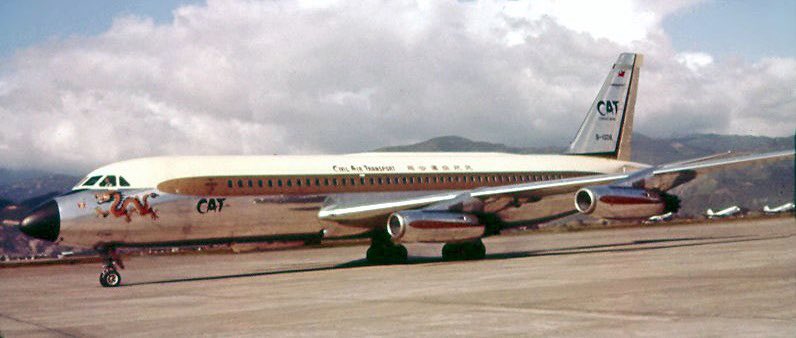
Kuomintang forces in the civil war between them and the communists under Mao Zedong. Many of its first pilots were veterans of Chennault's World War II combat groups, popularly known as Flying Tigers. (Other of Chennault's veterans formed the Flying Tiger Line. A separate 

operation from Civil Air Transport and the follow-on Air America.)
The CIA formed a private Delaware corporation called Airdale Corporation, which formed a subsidiary called CAT, Inc.
The Pacific Corporation (originally Airdale Corporation) was a holding company that the
The CIA formed a private Delaware corporation called Airdale Corporation, which formed a subsidiary called CAT, Inc.
The Pacific Corporation (originally Airdale Corporation) was a holding company that the
Central Intelligence Agency used to control several aviation front companies.
Former US Army pilot George A. Doole Jr. created Pacific Corporation, incorporated in Delaware in 1950. He concealed the agency's involvement by shuffling aircraft continuously among various shell
Former US Army pilot George A. Doole Jr. created Pacific Corporation, incorporated in Delaware in 1950. He concealed the agency's involvement by shuffling aircraft continuously among various shell
corporations and altering aircraft registration numbers.
Pacific's affiliates included:
•Actus Technology
•Air America, originally named Civil Air Transport, defunct
•Air Asia Co. Ltd., air maintenance activity
•Intermountain Airlines, became Evergreen International
Pacific's affiliates included:
•Actus Technology
•Air America, originally named Civil Air Transport, defunct
•Air Asia Co. Ltd., air maintenance activity
•Intermountain Airlines, became Evergreen International
Airlines
•Seaboard World Services
•Southern Air Transport, privatized as Southern Air
•Thai Pacific Services
Air America planes carried drugs during the CIA's secret war in Laos, though there is debate about whether Air America and the CIA were actively involved or
•Seaboard World Services
•Southern Air Transport, privatized as Southern Air
•Thai Pacific Services
Air America planes carried drugs during the CIA's secret war in Laos, though there is debate about whether Air America and the CIA were actively involved or
merely allowed others to transport drugs. During this war, the CIA used the Meo (Hmong) population to fight Pathet Lao rebels. Because of the war against Pathet Lao rebels, the Hmong depended upon poppy cultivation for hard currency.
Air Asia was a wholly owned subsidiary of
Air Asia was a wholly owned subsidiary of
Air America which provided technical, management, and equipment services for Civil Air Transport of Formosa. Air Asia was headquartered in Taipei and its main facilities were in Tainan, Taiwan. It is now located in the Tainan Airport. It is the only surviving member of the
Pacific Corporation, but currently it is owned by Taiwan Aerospace Corporation and is “no longer related to the Central Intelligence Agency”.
Delford M. Smith founded the company as Evergreen Helicopters in 1960. Smith was involved in the development of the commercial use of
Delford M. Smith founded the company as Evergreen Helicopters in 1960. Smith was involved in the development of the commercial use of
helicopters, and his company was one of the first to use helicopters for spraying fertilizer and herbicides, spreading seeds and fighting forest fires. Smith helped develop a helicopter spray system called the "PaceSpreader" which permitted accurate, fast delivery of granular
agents over large areas.
Evergreen bought assets during the 1970s that were previously linked to CIA operations, including Montana’s Johnson Flying Service and the CIA’s aviation "skunk works" at Pinal Airpark in Marana, Arizona.
Marana became the headquarters of all
Evergreen bought assets during the 1970s that were previously linked to CIA operations, including Montana’s Johnson Flying Service and the CIA’s aviation "skunk works" at Pinal Airpark in Marana, Arizona.
Marana became the headquarters of all
Central Intelligence Agency air operations during the Vietnam War years, when it was the primary facility of Intermountain Airlines, a wholly owned CIA "front" company which was used to supply covert operations in Southeast Asia and elsewhere.
Marana was the principal
Marana was the principal
continental United States maintenance base for Southeast Asia CIA operations including Air America and Continental Air Services.
In 1955 Continental merged with Pioneer Air Lines, gaining access to 16 more cities in Texas and New Mexico.
Pioneer's Executive Vice President
In 1955 Continental merged with Pioneer Air Lines, gaining access to 16 more cities in Texas and New Mexico.
Pioneer's Executive Vice President
Harding Luther Lawrence arrived at Continental as a result of the merger. Bob Six commented on more than one occasion that, "the reason we bought Pioneer was to get Harding."
Lawrence left Continental in April 1965 to head Braniff Airways.
Lawrence left Continental in April 1965 to head Braniff Airways.
Lawrence was bold with his management of Braniff even attempting to take over the much larger Pan American World Airways, Inc. in the early 1970s, which would have served the dual purpose of making Braniff a worldwide air carrier and giving Pan Am access to a United States 

domestic feeder system. Pan Am's Chairman Najeeb Halaby unfortunately refused the idea, preferring to pursue a merger with international competitor Trans World Airlines.
Najeeb Elias "Jeeb" Halaby, Jr. (Arabic: نجيب إلياس حلبي; November 19, 1915 – July 2, 2003) was CEO of Pan Am
Najeeb Elias "Jeeb" Halaby, Jr. (Arabic: نجيب إلياس حلبي; November 19, 1915 – July 2, 2003) was CEO of Pan Am
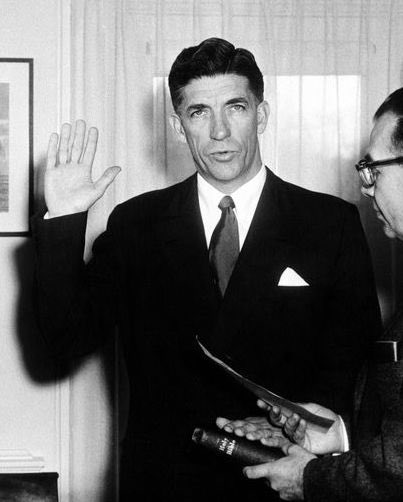
and the father of Queen Noor of Jordan.
Halaby was a graduate of The Leelanau School, a boarding school in Glen Arbor Township, Michigan
After the war he served as the U.S. State Department's civil aviation advisor to King Abdul Aziz Ibn Saud of Saudi Arabia, helping the King


Halaby was a graduate of The Leelanau School, a boarding school in Glen Arbor Township, Michigan
After the war he served as the U.S. State Department's civil aviation advisor to King Abdul Aziz Ibn Saud of Saudi Arabia, helping the King
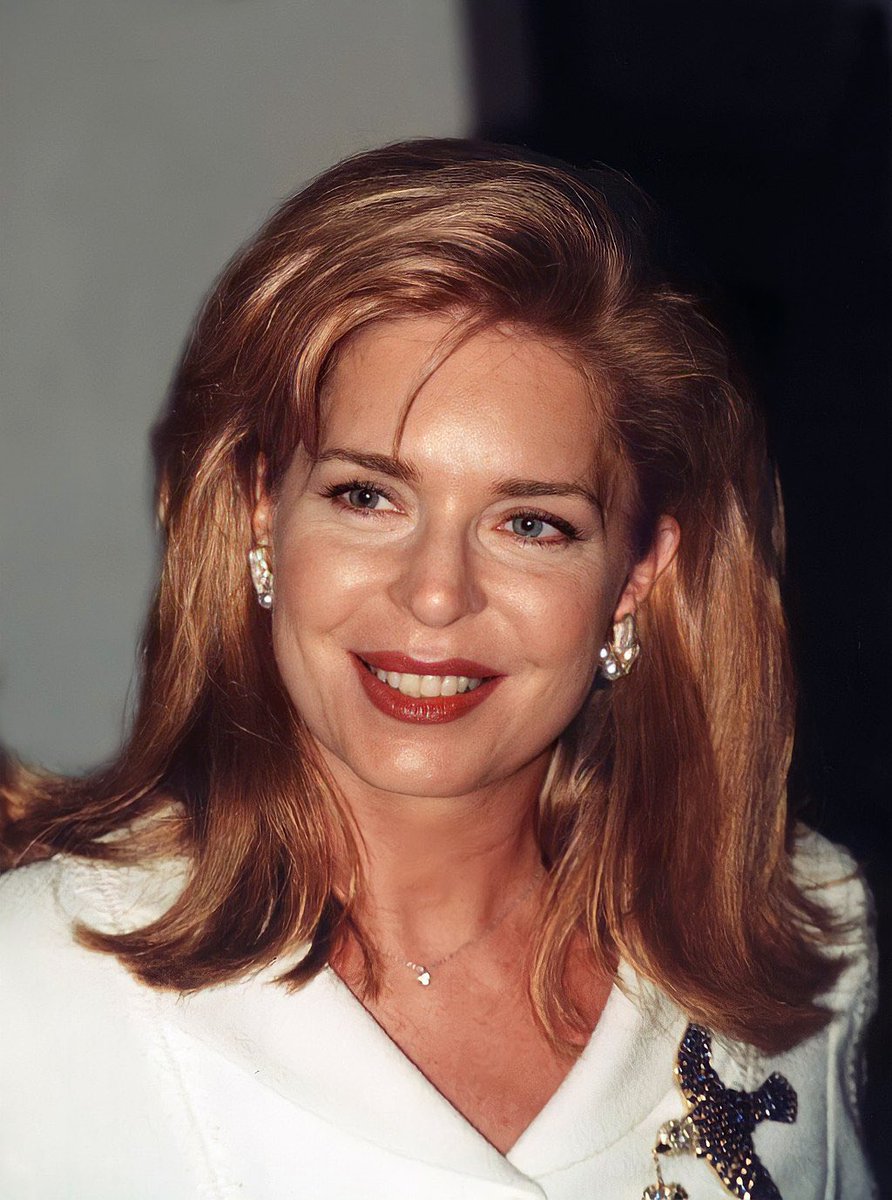

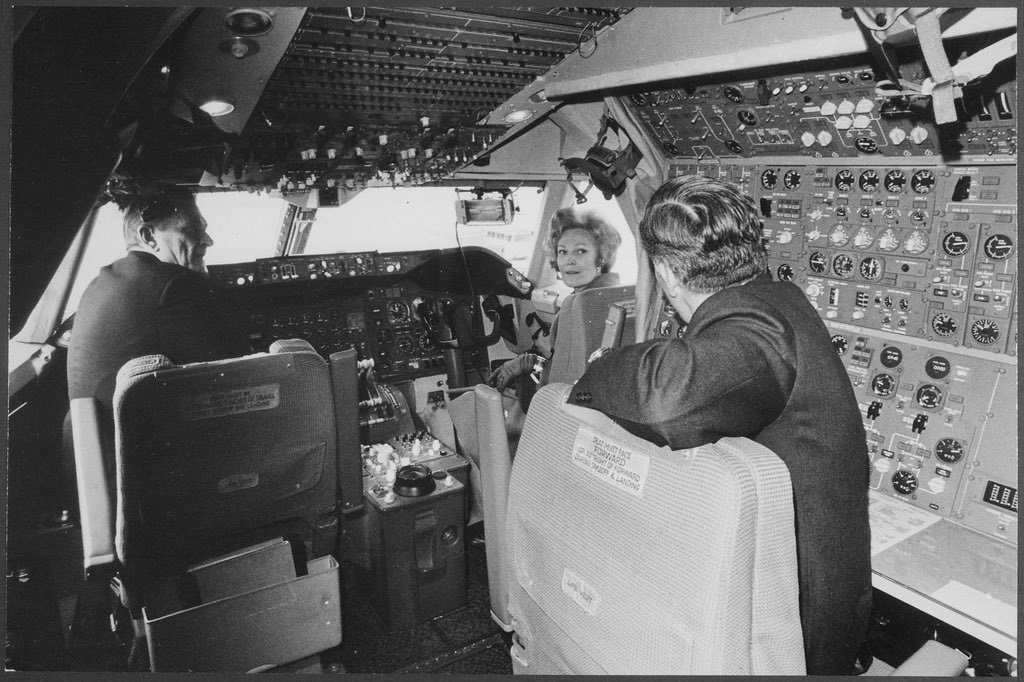
develop Saudi Arabian Airlines. Next, he worked as an aide to Secretary of Defense James Forrestal in the late 1940s, then helped Paul Nitze write NSC 68.He joined Laurance Rockefeller's family office in 1953, reviewing investments in civil aviation.
[In October 2021, Dimitri


[In October 2021, Dimitri
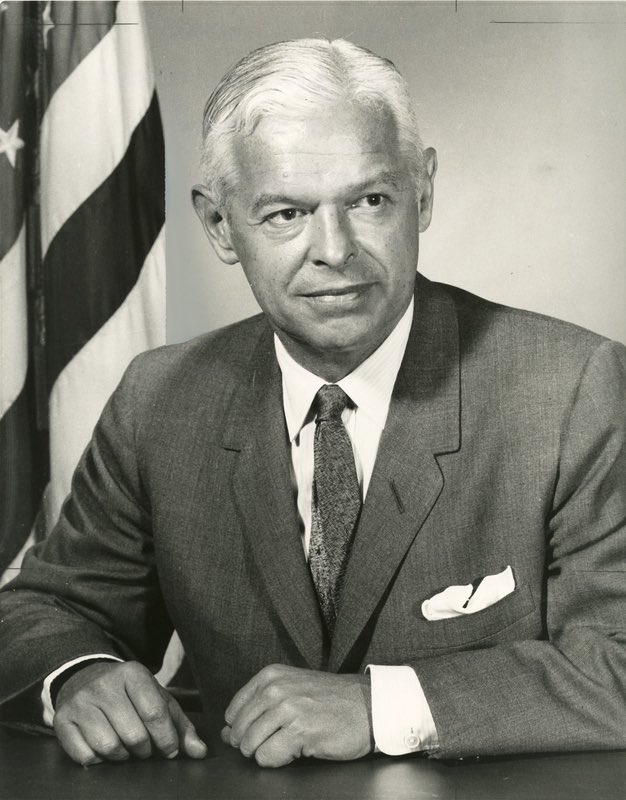


Alperovitch announced the launch of the Alperovitch Institute for Cybersecurity Studies to be based at the Johns Hopkins University's Paul H. Nitze School of Advanced International Studies.]
Laurance Spelman Rockefeller (May 26, 1910 – July 11, 2004) was an American
Laurance Spelman Rockefeller (May 26, 1910 – July 11, 2004) was an American
businessman, financier, philanthropist, and conservationist. Rockefeller was the third son and fourth child of John D. Rockefeller Jr. and Abby Aldrich Rockefeller. As a trustee of the Rockefeller Brothers Fund, he provided venture capital for Intel, Apple & More. 

On August 22, 1934, in Woodstock, Vermont, Laurance married childhood friend Mary French, whose mother, Mary Montague Billings French, was a friend of Laurance's mother.
When brother Nelson attended Dartmouth College, he shared a room with Mary's brother. Mary was granddaughter
When brother Nelson attended Dartmouth College, he shared a room with Mary's brother. Mary was granddaughter
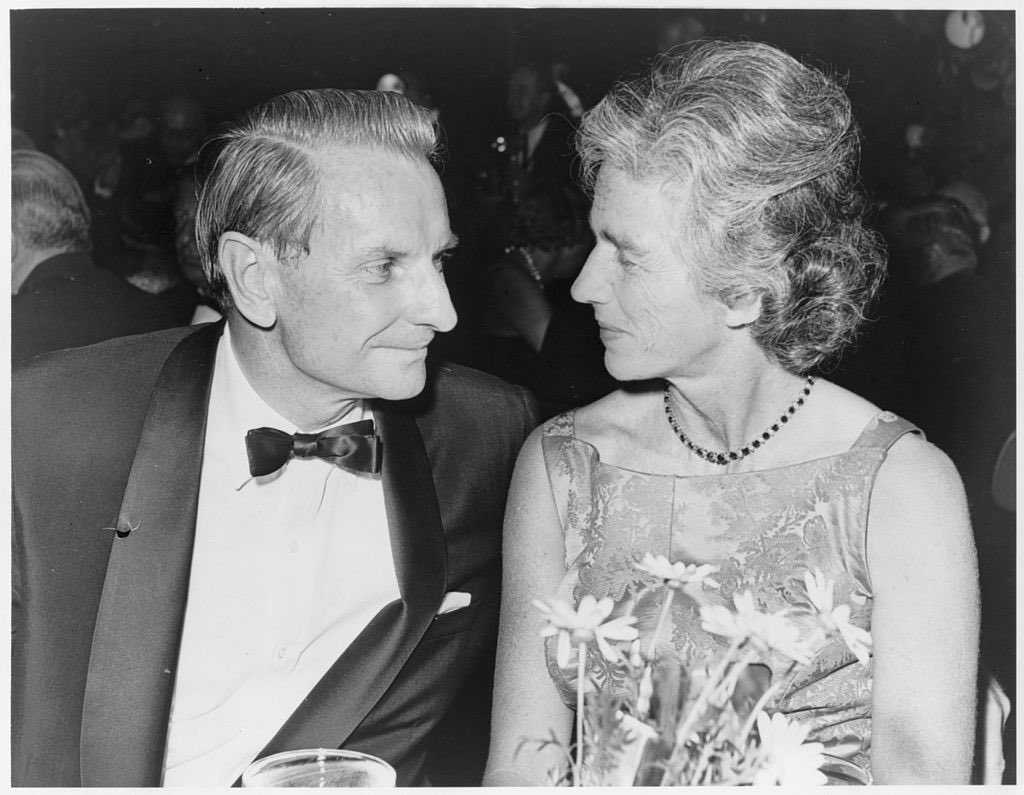
of Frederick H. Billings, a president of Northern Pacific Railway.
He was a leading figure in the pioneering field of venture capital, founding a joint partnership with all five brothers and their only sister, Babs, in 1946. In 1969 this became the successful Venrock Associates.
He was a leading figure in the pioneering field of venture capital, founding a joint partnership with all five brothers and their only sister, Babs, in 1946. In 1969 this became the successful Venrock Associates.
Larry Rockefeller's major interest was in aviation; after the War, he became friendly with Captain Eddie Rickenbacker, who had triumphed in many dogfights over Europe. Rockefeller had learned to fly, and found Rickenbacker's vivid accounts of an approaching boom in commercial air
travel to be persuasive. Within a decade after Rockefeller's considerable investment, Eastern Airlines had become the most profitable airline to emerge after World War II. He became its largest shareholder.
Venture capitalist Laurance S. Rockefeller (1910–2004) was the fourth
Venture capitalist Laurance S. Rockefeller (1910–2004) was the fourth
of the six children of John D. Rockefeller, Jr. In January 1946 he formed Rockefeller Brothers, Inc., one of the first postwar venture-capital operations.
There were eight partners in all, the five brothers and their sister, Abby, and two non family members Harper Woodward and
There were eight partners in all, the five brothers and their sister, Abby, and two non family members Harper Woodward and

MIT scientist, Ted Walkowicz.
WHEN Wall Streeters urged Ted Walkowicz to open the. National Aviation and Technology Corporation fund to new investment, he said that National Aviation had been in business for 50 years and that shareholders had been happy with its performance as
WHEN Wall Streeters urged Ted Walkowicz to open the. National Aviation and Technology Corporation fund to new investment, he said that National Aviation had been in business for 50 years and that shareholders had been happy with its performance as
a fixed‐capital or “closed‐end” fund.
Opening Up A Closed Fund
But Wall Streeters led by Neuberger & Berman persisted and bought National Aviation shares in the stock market.
Notable Nuddieberger & Bergman employees:
•Larry Zicklin
•Roy Neuberger
•Steve Eisman
Opening Up A Closed Fund
But Wall Streeters led by Neuberger & Berman persisted and bought National Aviation shares in the stock market.
Notable Nuddieberger & Bergman employees:
•Larry Zicklin
•Roy Neuberger
•Steve Eisman
•Anthony Scaramucci
•George Herbert Walker IV
•Walter Luhr
George Herbert Walker IV (born April 1969) is the chairman and CEO of Neuberger Berman, one of the largest independent, employee-owned investment management firms. During Walker's tenure, the firm survived the
•George Herbert Walker IV
•Walter Luhr
George Herbert Walker IV (born April 1969) is the chairman and CEO of Neuberger Berman, one of the largest independent, employee-owned investment management firms. During Walker's tenure, the firm survived the
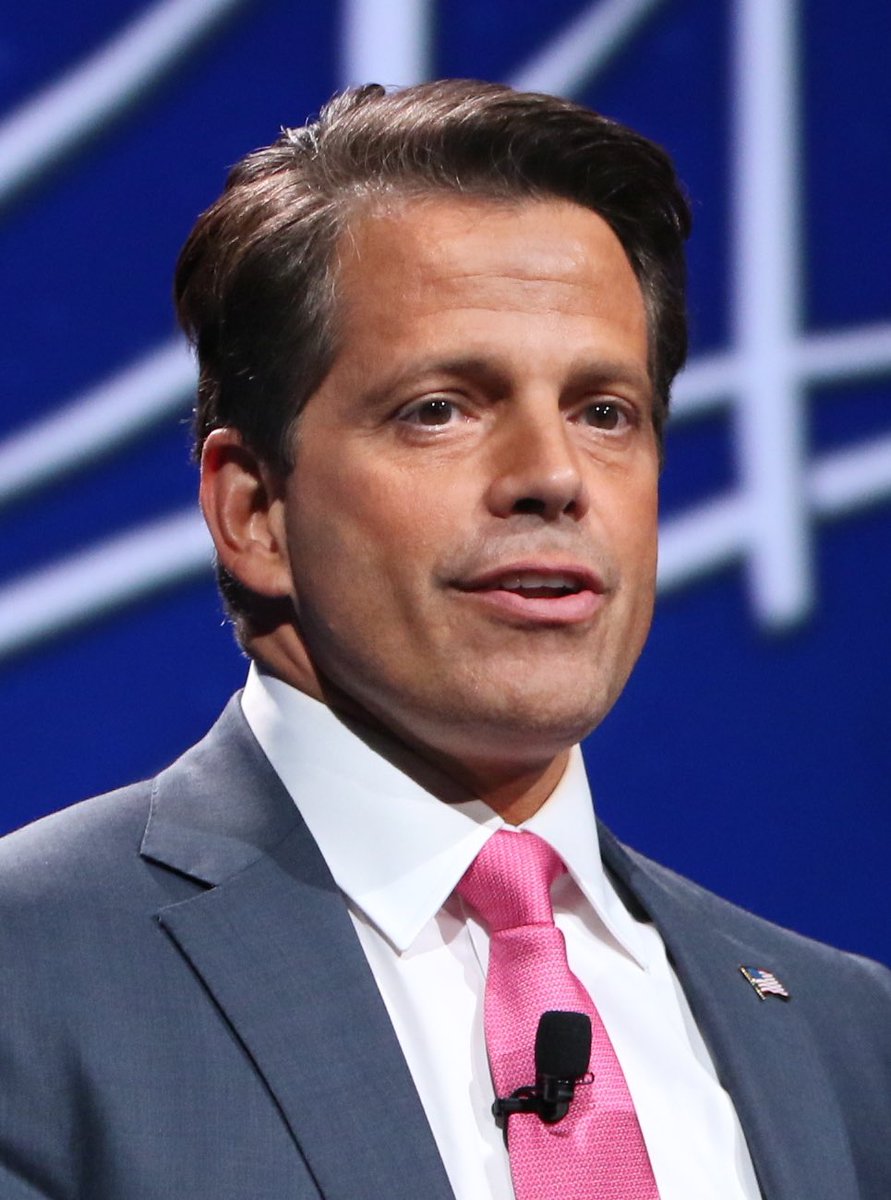
implosion of its corporate parent, Lehman Brothers.
Walker comes from a successful family of industrialists and financiers, originally from St. Louis, Missouri. Walker's great-grandfather, George Herbert Walker, was the founder of G. H. Walker & Co., a securities firm, which
Walker comes from a successful family of industrialists and financiers, originally from St. Louis, Missouri. Walker's great-grandfather, George Herbert Walker, was the founder of G. H. Walker & Co., a securities firm, which
eventually became part of Merrill Lynch. An avid golfer, he was also the namesake of amateur golf's Walker Cup. His grandfather, George Herbert Walker Jr., was a co-founder of the NY Mets and his father, George Herbert Walker III, was U. S. ambassador to Hungary. Walker was
raised in St. Louis, Missouri and has a younger sister, Carter. Walker's grand-aunt, Dorothy, married Senator Prescott Bush, father of U.S. President George Herbert Walker Bush and grandfather of U.S. President George Walker Bush. He is thus the first cousin once removed of f
ormer President George H. W. Bush, and the second cousin of former President George W. Bush.
Originally called National Aviation Corp., the fund was formed by a group of businessmen and aviation pioneers who foresaw tremendous growth for the aviation industry -- and wanted a
Originally called National Aviation Corp., the fund was formed by a group of businessmen and aviation pioneers who foresaw tremendous growth for the aviation industry -- and wanted a
way to invest in that growth.
The chairman of the board was Clement M. Keys, president of Curtiss Aeroplane and Motor Co. Directors included Eddie Rickenbacker, a World War I ace who later became head of Eastern Airlines; Richard F. Hoyt, chairman of Wright Aeronautical Corp.;
The chairman of the board was Clement M. Keys, president of Curtiss Aeroplane and Motor Co. Directors included Eddie Rickenbacker, a World War I ace who later became head of Eastern Airlines; Richard F. Hoyt, chairman of Wright Aeronautical Corp.;
and Sherman M. Fairchild, president of Fairchild Aviation Corp.
Other members were Paul W. Litchfield, president of the Goodyear Tire & Rubber Co., and David Sarnoff, president of Radio Corporation of America (RCA).
The aviation fund, whose shares traded on the New York Stock
Other members were Paul W. Litchfield, president of the Goodyear Tire & Rubber Co., and David Sarnoff, president of Radio Corporation of America (RCA).
The aviation fund, whose shares traded on the New York Stock
Exchange, was started with $3 million. It invested not only in the stocks of air transportation companies, but also helped start and finance new companies, including Curtiss Flying Service Inc., Sikorsky Aviation Corp. and North American Aviation Inc. The fund also owned
Washington Air Terminal and the land on which the Pentagon now stands.
The year was 1928 and flying machines were all the rage. A year earlier, Charles Lindbergh had electrified the world with his nonstop solo flight across the Atlantic to Paris. Each day's newspaper told of
The year was 1928 and flying machines were all the rage. A year earlier, Charles Lindbergh had electrified the world with his nonstop solo flight across the Atlantic to Paris. Each day's newspaper told of
pilots setting new distance or speed records.
It also was the year that the John Hancock National Aviation & Technology Fund was launched.
Harper Woodward, a lawyer and business associate of Laurance S. Rockefeller for 34 years and an adviser to the Rockefeller family, died of
It also was the year that the John Hancock National Aviation & Technology Fund was launched.
Harper Woodward, a lawyer and business associate of Laurance S. Rockefeller for 34 years and an adviser to the Rockefeller family, died of
cancer Wednesday at the Connecticut Hospital in Branford. Mr. Woodward was a longtime resident of Rye, N.Y.
He joined Mr. Rockefeller in 1946 and played major roles in his venture capital investments, including the early development of companies that manufactured
He joined Mr. Rockefeller in 1946 and played major roles in his venture capital investments, including the early development of companies that manufactured
aircraft-related equipment, rocket and ramjet engines, graphic-arts products and electronic devices. He was also a director of Rockresorts Inc. and had assisted in the building of resorts in the Caribbean and Hawaii.
Mr. Woodward, a native of Rochester, graduated from St.
Mr. Woodward, a native of Rochester, graduated from St.
Paul's School, Concord, N.H., and, in 1931, from Harvard College. He graduated from Harvard Law School in 1934 and the next year became secretary to the president of Harvard, James B. Conant.
During World War II he served as a colonel in the Army Air Force, and from 1943 to
During World War II he served as a colonel in the Army Air Force, and from 1943 to
1945 was a member of the advisory council to General of the Army Henry H. Arnold.
Mr. Woodward is survived by his wife, the former Edith D. Mackinney; four children, Bonnie B. Christen of Geneva; Belinda B, Kendall of Moraga, Calif.; Bruce A. Woodward of Garden City, L.I., and
Mr. Woodward is survived by his wife, the former Edith D. Mackinney; four children, Bonnie B. Christen of Geneva; Belinda B, Kendall of Moraga, Calif.; Bruce A. Woodward of Garden City, L.I., and
Edwin C. Laird 3d of Bellevue, Wash.; a sister, Mrs. Arthur B. Treman of Vero Beach, Fla; a brother, Beavan Woodward of Tampa, Fla., and three grandchildren.
Southern Air Transport (SAT) (1947–1998), based in Miami, Florida, was a cargo airline best known as a front company for
Southern Air Transport (SAT) (1947–1998), based in Miami, Florida, was a cargo airline best known as a front company for
the Central Intelligence Agency (CIA) (1960–1973) and for its crucial role in the Iran-Contra scandal in the mid-1980s.
As part of Oliver North's activities to trade arms for hostages with Iran and to support the contra rebellion in Nicaragua, Southern Air carried four loads
As part of Oliver North's activities to trade arms for hostages with Iran and to support the contra rebellion in Nicaragua, Southern Air carried four loads
of US weapons bound for Iran from the US to Israel, and on the return flights carried weapons destined for the US-backed right-wing Contra rebels in Nicaragua from Portugal. On 5 October 1986, a Southern Air Transport C-123K, loaded with weapons, failed to return from a
scheduled drop to the Contras in Nicaragua. In charge of the operation was Felix Rodriguez. He was the logistics officer for airlifts of weapons and supplies from the Ilopango air base, in El Salvador, to the jungle hide-outs of the Contras. Rodriguez did not notify the Defense
Department or the CIA but rather attempted to get word about the missing C-123K to Donald Gregg, the National Security Advisor for Vice President George H. W. Bush. The shooting down of an SAT flight helped expose the Iran-Contra scandal.
Logbooks retrieved from the wreckage
Logbooks retrieved from the wreckage
linked SAT to a history of involvement with the CIA, cocaine and the Medellin drug cartel.
In 1994, Edmund James, president of James and Donohew Development Services, negotiated with SAT and announced that it was locating to Rickenbacker International Airport in Columbus, Ohio.
In 1994, Edmund James, president of James and Donohew Development Services, negotiated with SAT and announced that it was locating to Rickenbacker International Airport in Columbus, Ohio.
• • •
Missing some Tweet in this thread? You can try to
force a refresh

